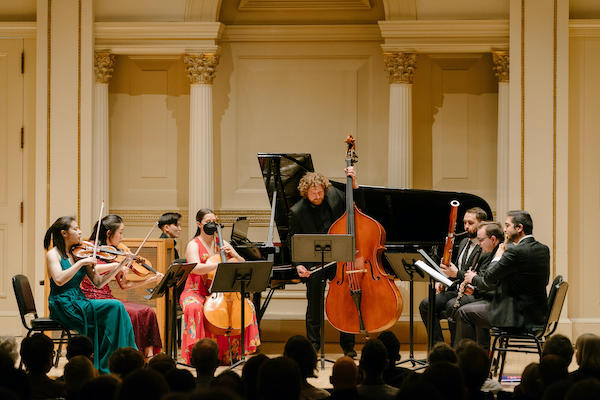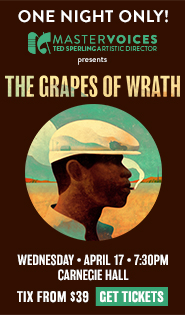From Brahms to a Saariaho premiere, Ensemble Connect provides versatile, luminous advocacy

Ensemble Connect returned to Weil Recital Hall with a program of chamber music equally divided between the romantic and the contemporary. The Schumann and Brahms were lovely and expertly performed, but the highpoint was the world premiere of Finnish composer Kaija Saariaho’s Semafor, co-commissioned by Carnegie Hall and the Santa Fe Chamber Music Festival.
Launched in 2007, Ensemble Connect was conceived by Carnegie Hall’s executive and artistic director Clive Gillinson. Based at Carnegie Hall, the two-year post-graduate program is a partnership with The Juilliard School and the New York City Department of Education. Beyond performing, the participants partner with instrumental teachers in New York City schools to provide inspiration and guidance to aspiring young musicians, in addition to sharing their artistry.
Acclaimed as one of the world’s greatest living composers, Saariaho is the most noted exponent of spectralism, which takes the material attributes of sound as the point of departure for composition. Her singular style is characterized by rich, polyphonic textures often created by combining live music and electronics. She has the distinction of being the second woman composer to have had an opera, L’Amour de loin, staged at the Metropolitan Opera in 2016. (The first was Ethel Smyth with Der Wald in 1903.)
In introducing the work, flutist Amir Farsi related that Semafor was Saariaho’s last composition before a sabbatical, planned in advance of the pandemic. The players had a singled coaching session with her via Zoom, in which she described the work as her attempt to capture the sounds of a bustling city. Scored for woodwinds, strings, piano and celesta, Semafor is just as Farsi described it to the audience: tumultuous and colorful.
Saariaho writes that the title of the work is a reference to the late Finnish artist Ernst Mether-Bergström and his colorful and playful Semafor sculptures. Musically, Saariaho’s inspiration were what she terms, the ”obsessive octaves” in her orchestra work Vista. Normally octaves are a means of releasing harmonic tension in her work, but in Semafor, they do just the opposite.
One could easily imagine being a traffic cop at a busy intersection in Manhattan directing traffic at rush hour while listening to Semafor, but just as readily a bicyclist darting through the city traffic. Saariaho vividly depicted the stops and starts of the flow of traffic with sudden changes in mood and tempo. One moment there is a musical frenzy with ominous sounds flowing from the ensemble, the next a hypnotic period of repose. In the middle of the work, it is woodwinds versus strings in musical combat before they unite in a calmer, more harmonic sonic flow. A beautiful bassoon solo, performed by Nik Hooks, leads to the luminous, soft conclusion of the piece.
Hooks was also the soloist in Wynton Marsalis’ Meeelaan, a play on the name of renowned bassoonist Milan Turkovic for whom it was composed. Scored for bassoon and string quartet, Meeelaan had its first performance in Buenos Aires in 2000 and in New York the following year. In introducing the work, Hooks said that that the five musicians envisioned the work as depicting the ebb and flow in the relationship of two long-time friends. His words provided the framework for the three-movement work with its exciting combination of blues, tango and bebop.
Unlike his earlier work for viola and piano, Märchenbilder, Schumann did not spell out which fairy tales inspired his trio for clarinet, viola and piano entitled Märchenerzählungen. Composed in 1853, it is one of the composer’s last compositions, before his final descent into madness and eventual death the following year. This enchanting performance alternated between bewitching elegance, mystery and drama, before the culminating in a beautiful exchange in the final movement between violist Halam Kim and clarinetist Yasmina Spiegelberg.
Brahms was a horn player in his youth, having received instruction from his father. The younger Brahms was skilled enough to play first horn in the orchestra at Detmold. Composed in 1865, the Trio in E-flat Major for violin, horn, and piano is cast in nostalgia, not only as a musical reminiscence of his childhood, but also to commemorate the death of the composer’s mother earlier that year.
Brahms had a preference for the natural horn and composed the trio for it specifically, although he authorized the use of the valved horn, the latter of which was played by Cort Roberts in this performance. Partnered by violinist Stephanie Zyzak, the trio’s poignant third movement was an exquisite melodic dialogue between violin and horn.
Pianist Joanne Kang, though often unseen for most of the evening, was a crucial element throughout, providing keyboard playing in the Schumann, Saariaho and Brahms that really made this concert pop.
Ensemble Connect returns to Carnegie Hall on May 2 with a concert of new music by American composers. carnegiehall.org




Posted May 06, 2022 at 3:21 pm by Gma
Thank you so much for this